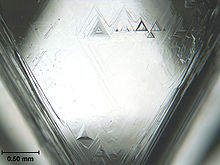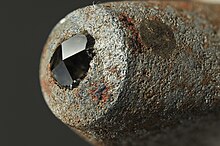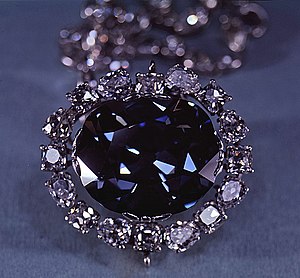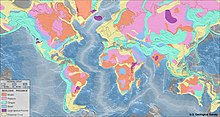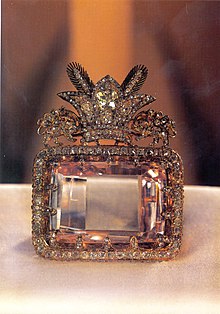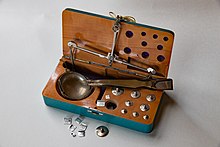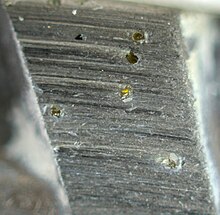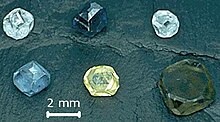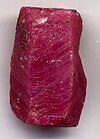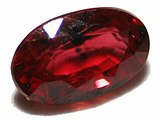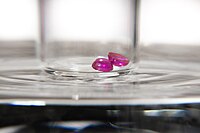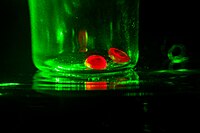| Diamond | |
|---|---|

The
slightly misshapen octahedral shape of this rough diamond crystal in
matrix is typical of the mineral. Its lustrous faces also indicate that
this crystal is from a primary deposit.
| |
| General | |
| Category | Native minerals |
| Formula (repeating unit) | C |
| Strunz classification | 1.CB.10a |
| Dana classification | 1.3.6.1 |
| Crystal system | Cubic |
| Crystal class | Hexoctahedral (m3m) H-M symbol: (4/m 3 2/m) |
| Structure | |
| Jmol (3D) | Interactive image |
| Identification | |
| Formula mass | 12.01 g/mol |
| Color | Typically yellow, brown, or gray to colorless. Less often blue, green, black, translucent white, pink, violet, orange, purple, and red. |
| Crystal habit | Octahedral |
| Twinning | Spinel law common (yielding "macle") |
| Cleavage | 111 (perfect in four directions) |
| Fracture | Irregular/Uneven |
| Mohs scale hardness | 10 (defining mineral) |
| Luster | Adamantine |
| Streak | Colorless |
| Diaphaneity | Transparent to subtransparent to translucent |
| Specific gravity | 3.52±0.01 |
| Density | 3.5–3.53 g/cm3 |
| Polish luster | Adamantine |
| Optical properties | Isotropic |
| Refractive index | 2.418 (at 500 nm) |
| Birefringence | None |
| Pleochroism | None |
| Dispersion | 0.044 |
| Melting point | Pressure dependent |
Diamond is a solid form of the element carbon with its atoms arranged in a crystal structure called diamond cubic. At room temperature and pressure, another solid form of carbon known as graphite is the chemically stable form, but diamond almost never converts to it. Diamond has the highest hardness and thermal conductivity of any natural material, properties that are utilized in major industrial applications such as cutting and polishing tools. They are also the reason that diamond anvil cells can subject materials to pressures found deep in the Earth.
Because the arrangement of atoms in diamond is extremely rigid, few types of impurity can contaminate it (two exceptions being boron and nitrogen). Small numbers of defects or impurities (about one per million of lattice atoms) color diamond blue (boron), yellow (nitrogen), brown (defects), green (radiation exposure), purple, pink, orange or red. Diamond also has relatively high optical dispersion (ability to disperse light of different colors).
Most natural diamonds have ages between 1 billion and 3.5 billion years. Most were formed at depths between 150 and 250 kilometers (93 and 155 mi) in the Earth's mantle, although a few have come from as deep as 800 kilometers (500 mi). Under high pressure and temperature, carbon-containing fluids dissolved minerals and replaced them with diamonds. Much more recently (tens to hundreds of million years ago), they were carried to the surface in volcanic eruptions and deposited in igneous rocks known as kimberlites and lamproites.
Synthetic diamonds can be grown from high-purity carbon under high pressures and temperatures or from hydrocarbon gas by chemical vapor deposition (CVD). Imitation diamonds can also be made out of materials such as cubic zirconia and silicon carbide. Natural, synthetic and imitation diamonds are most commonly distinguished using optical techniques or thermal conductivity measurements.
Material properties
Diamond is a solid form of pure carbon with its atoms arranged in a crystal. Solid carbon comes in different forms known as allotropes depending on the type of chemical bond. The two most common allotropes of pure carbon are diamond and graphite. In graphite the bonds are sp2 orbital hybrids and the atoms form in planes with each bound to three nearest neighbors 120 degrees apart. In diamond they are sp3 and the atoms form tetrahedra with each bound to four nearest neighbors. Tetrahedra are rigid, the bonds are strong, and of all known substances diamond has the greatest number of atoms per unit volume, which is why it is both the hardest and the least compressible. It also has a high density, ranging from 3150 to 3530 kilograms per cubic metre (over three times the density of water) in natural diamonds and 3520 kg/m³ in pure diamond. In graphite, the bonds between nearest neighbors are even stronger but the bonds between planes are weak, so the planes can easily slip past each other. Thus, graphite is much softer than diamond. However, the stronger bonds make graphite less flammable.Diamonds have been adapted for many uses because of the material's exceptional physical characteristics. Most notable are its extreme hardness and thermal conductivity (900–{{val|2320|u=watts per centimeter per kelvin ), as well as wide bandgap and high optical dispersion. Diamond's ignition point is 720–800 °C in oxygen and 850–1000 °C in air.
Thermodynamics
Theoretically predicted phase diagram of carbon
The equilibrium pressure and temperature conditions for a transition
between graphite and diamond is well established theoretically and
experimentally. The pressure changes linearly between 1.7 GPa at 0 K and 12 GPa at 5000 K (the diamond/graphite/liquid triple point).
However, the phases have a wide region about this line where they can coexist. At normal temperature and pressure, 20 °C (293 K) and 1 standard atmosphere (0.10 MPa), the stable phase of carbon is graphite, but diamond is metastable and its rate of conversion to graphite is negligible. However, at temperatures above about 4500 K,
diamond rapidly converts to graphite. Rapid conversion of graphite to
diamond requires pressures well above the equilibrium line: at 2000 K, a pressure of 35 GPa is needed.
Above the triple point, the melting point of diamond increases
slowly with increasing pressure; but at pressures of hundreds of GPa, it
decreases. At high pressures, silicon and germanium have a BC8 body-centered cubic crystal structure, and a similar structure is predicted for carbon at high pressures. At 0 K, the transition is predicted to occur at 1100 GPa.
Crystal structure
Diamond unit cell, showing the tetrahedral structure.
The most common crystal structure of diamond is called diamond cubic. It is formed of unit cells
(see the figure) stacked together. Although there are 18 atoms in the
figure, each corner atom is shared by eight unit cells and each atom in
the center of a face is shared by two, so there are a total of eight
atoms per unit cell. Each side of the unit cell is 3.57 angstroms in length.
A diamond cubic lattice can be thought of as two interpenetrating face-centered cubic
lattices with one displaced by 1/4 of the diagonal along a cubic cell,
or as one lattice with two atoms associated with each lattice point. Looked at from a <1 1=""> crystallographic direction,
it is formed of layers stacked in a repeating ABCABC ... pattern.
Diamonds can also form an ABAB ... structure, which is known as
hexagonal diamond or lonsdaleite, but this is far less common and is formed under different conditions from cubic carbon.
Crystal habit
One face of an uncut octahedral diamond, showing trigons (of positive and negative relief) formed by natural chemical etching
Diamonds occur most often as euhedral or rounded octahedra and twinned octahedra known as macles. As diamond's crystal structure has a cubic arrangement of the atoms, they have many facets that belong to a cube, octahedron, rhombicosidodecahedron, tetrakis hexahedron or disdyakis dodecahedron.
The crystals can have rounded off and unexpressive edges and can be
elongated. Diamonds (especially those with rounded crystal faces) are
commonly found coated in nyf, an opaque gum-like skin.
Some diamonds have opaque fibers. They are referred to as opaque if the fibers grow from a clear substrate or fibrous
if they occupy the entire crystal. Their colors range from yellow to
green or gray, sometimes with cloud-like white to gray impurities. Their
most common shape is cuboidal, but they can also form octahedra,
dodecahedra, macles or combined shapes. The structure is the result of
numerous impurities with sizes between 1 and 5 microns. These diamonds
probably formed in kimberlite magma and sampled the volatiles.
Diamonds can also form polycrystalline aggregates. There have been attempts to classify them into groups with names such as boart, ballas, stewartite and framesite, but there is no widely accepted set of criteria. Carbonado, a type in which the diamond grains were sintered (fused without melting by the application of heat and pressure), is black in color and tougher than single crystal diamond.
It has never been observed in a volcanic rock. There are many theories
for its origin, including formation in a star, but no consensus.
Mechanical properties
Hardness
The
extreme hardness of diamond in certain orientations makes it useful in
materials science, as in this pyramidal diamond embedded in the working
surface of a Vickers hardness tester.
Diamond is the hardest known natural material on both the Vickers scale and the Mohs scale. Diamond's great hardness relative to other materials has been known since antiquity, and is the source of its name.
Diamond hardness depends on its purity, crystalline perfection
and orientation: hardness is higher for flawless, pure crystals oriented
to the <111> direction (along the longest diagonal of the cubic diamond lattice). Therefore, whereas it might be possible to scratch some diamonds with other materials, such as boron nitride, the hardest diamonds can only be scratched by other diamonds and nanocrystalline diamond aggregates.
The hardness of diamond contributes to its suitability as a
gemstone. Because it can only be scratched by other diamonds, it
maintains its polish extremely well. Unlike many other gems, it is
well-suited to daily wear because of its resistance to
scratching—perhaps contributing to its popularity as the preferred gem
in engagement or wedding rings, which are often worn every day.
The hardest natural diamonds mostly originate from the Copeton and Bingara fields located in the New England area in New South Wales,
Australia. These diamonds are generally small, perfect to semiperfect
octahedra, and are used to polish other diamonds. Their hardness is
associated with the crystal growth
form, which is single-stage crystal growth. Most other diamonds show
more evidence of multiple growth stages, which produce inclusions,
flaws, and defect planes in the crystal lattice, all of which affect
their hardness. It is possible to treat regular diamonds under a
combination of high pressure and high temperature to produce diamonds
that are harder than the diamonds used in hardness gauges.
Toughness
Somewhat related to hardness is another mechanical property toughness, which is a material's ability to resist breakage from forceful impact. The toughness of natural diamond has been measured as 7.5–10 MPa·m1/2.
This value is good compared to other ceramic materials, but poor
compared to most engineering materials such as engineering alloys, which
typically exhibit toughnesses over 100 MPa·m1/2. As with any material, the macroscopic geometry of a diamond contributes to its resistance to breakage. Diamond has a cleavage plane and is therefore more fragile in some orientations than others. Diamond cutters use this attribute to cleave some stones, prior to faceting. "Impact toughness" is one of the main indexes to measure the quality of synthetic industrial diamonds.
Yield strength
Diamond has compressive yield strength of 130–140 GPa. This exceptionally high value, along with the hardness and transparency of diamond, are the reasons that diamond anvil cells are the main tool for high pressure experiments. These anvils have reached pressures of 600 GPa. Much higher pressures may be possible with nanocrystalline diamonds.
Elasticity and tensile strength
Usually, attempting to deform bulk diamond crystal by tension or
bending results in brittle fracture. However when single crystalline
diamond is in the form of nanometer-sized wires or needles (~100-300
nanometers in diameter), they can be elastically stretched by as much as
9 percent tensile strain without failure , with a maximum local tensile stress of ∼89 to 98 GPa, very close to the theoretical limit for this material.
Electrical conductivity
Other specialized applications also exist or are being developed, including use as semiconductors: some blue diamonds are natural semiconductors, in contrast to most diamonds, which are excellent electrical insulators.
The conductivity and blue color originate from boron impurity. Boron
substitutes for carbon atoms in the diamond lattice, donating a hole
into the valence band.
Substantial conductivity is commonly observed in nominally undoped diamond grown by chemical vapor deposition. This conductivity is associated with hydrogen-related species adsorbed at the surface, and it can be removed by annealing or other surface treatments.
Surface property
Diamonds are naturally lipophilic and hydrophobic,
which means the diamonds' surface cannot be wet by water, but can be
easily wet and stuck by oil. This property can be utilized to extract
diamonds using oil when making synthetic diamonds. However, when diamond
surfaces are chemically modified with certain ions, they are expected
to become so hydrophilic that they can stabilize multiple layers of water ice at human body temperature.
The surface of diamonds is partially oxidized. The oxidized
surface can be reduced by heat treatment under hydrogen flow. That is to
say, this heat treatment partially removes oxygen-containing functional
groups. But diamonds (sp3C) are unstable against high
temperature (above about 400 °C (752 °F)) under atmospheric pressure.
The structure gradually changes into sp2C above this temperature. Thus, diamonds should be reduced under this temperature.
Chemical stability
At room temperature, diamonds do not react with any chemical reagents
including strong acids and bases. A diamond's surface can only be
oxidized at temperatures above about 850 °C (1,560 °F) in air. Diamond
powder of an appropriate grain size (around 50 microns) burns with a
shower of sparks after ignition from a flame. Consequently, pyrotechnic compositions based on synthetic diamond
powder can be prepared. The resulting sparks are of the usual
red-orange color, comparable to charcoal, but show a very linear
trajectory which is explained by their high density. Diamond also reacts with fluorine gas above about 700 °C (1,292 °F).
Color
Brown diamonds at the National Museum of Natural History in Washington, D.C.
The most famous colored diamond, the Hope Diamond
Diamond has a wide bandgap of 5.5 eV corresponding to the deep ultraviolet
wavelength of 225 nanometers. This means that pure diamond should
transmit visible light and appear as a clear colorless crystal. Colors
in diamond originate from lattice defects and impurities. The diamond
crystal lattice is exceptionally strong, and only atoms of nitrogen, boron and hydrogen can be introduced into diamond during the growth at significant concentrations (up to atomic percents). Transition metals nickel and cobalt,
which are commonly used for growth of synthetic diamond by
high-pressure high-temperature techniques, have been detected in diamond
as individual atoms; the maximum concentration is 0.01% for nickel and even less for cobalt. Virtually any element can be introduced to diamond by ion implantation.
Nitrogen is by far the most common impurity found in gem diamonds
and is responsible for the yellow and brown color in diamonds. Boron is
responsible for the blue color.
Color in diamond has two additional sources: irradiation (usually by
alpha particles), that causes the color in green diamonds, and plastic deformation of the diamond crystal lattice. Plastic deformation is the cause of color in some brown and perhaps pink and red diamonds.
In order of increasing rarity, yellow diamond is followed by brown,
colorless, then by blue, green, black, pink, orange, purple, and red. "Black", or Carbonado,
diamonds are not truly black, but rather contain numerous dark
inclusions that give the gems their dark appearance. Colored diamonds
contain impurities or structural defects that cause the coloration,
while pure or nearly pure diamonds are transparent and colorless. Most
diamond impurities replace a carbon atom in the crystal lattice, known as a carbon flaw.
The most common impurity, nitrogen, causes a slight to intense yellow
coloration depending upon the type and concentration of nitrogen
present. The Gemological Institute of America (GIA) classifies low saturation yellow and brown diamonds as diamonds in the normal color range,
and applies a grading scale from "D" (colorless) to "Z" (light yellow).
Diamonds of a different color, such as blue, are called fancy colored diamonds and fall under a different grading scale.
In 2008, the Wittelsbach Diamond, a 35.56-carat (7.112 g) blue diamond once belonging to the King of Spain, fetched over US$24 million at a Christie's auction. In May 2009, a 7.03-carat (1.406 g) blue diamond
fetched the highest price per carat ever paid for a diamond when it was
sold at auction for 10.5 million Swiss francs (6.97 million euros, or
US$9.5 million at the time).
That record was, however, beaten the same year: a 5-carat (1.0 g) vivid
pink diamond was sold for $10.8 million in Hong Kong on December 1,
2009.
Identification
Diamonds can be identified by their high thermal conductivity. Their high refractive index
is also indicative, but other materials have similar refractivity.
Diamonds cut glass, but this does not positively identify a diamond
because other materials, such as quartz, also lie above glass on the Mohs scale
and can also cut it. Diamonds can scratch other diamonds, but this can
result in damage to one or both stones. Hardness tests are infrequently
used in practical gemology because of their potentially destructive
nature.
The extreme hardness and high value of diamond means that gems are
typically polished slowly, using painstaking traditional techniques and
greater attention to detail than is the case with most other gemstones;
these tend to result in extremely flat, highly polished facets with
exceptionally sharp facet edges. Diamonds also possess an extremely high
refractive index and fairly high dispersion. Taken together, these
factors affect the overall appearance of a polished diamond and most diamantaires still rely upon skilled use of a loupe (magnifying glass) to identify diamonds "by eye".
Geology
Diamonds are extremely rare, with concentrations of at most parts per billion in source rock. Before the 20th century, most diamonds were found in alluvial deposits. Loose diamonds are also found along existing and ancient shorelines, where they tend to accumulate because of their size and density. Rarely, they have been found in glacial till (notably in Wisconsin and Indiana), but these deposits are not of commercial quality. These types of deposit were derived from localized igneous intrusions through weathering and transport by wind or water.
Most diamonds come from the Earth's mantle, and most of this section discusses those diamonds. However, there are other sources. Some blocks of the crust, or terranes, have been buried deep enough as the crust thickened so they experienced ultra-high-pressure metamorphism. These have evenly distributed microdiamonds
that show no sign of transport by magma. In addition, when meteorites
strike the ground, the shock wave can produce high enough temperatures
and pressures for microdiamonds and nanodiamonds to form. Impact-type microdiamonds can be used as an indicator of ancient impact craters. Popigai crater in Russia may have the world's largest diamond deposit, estimated at trillions of carats, and formed by an asteroid impact.
A common misconception is that diamonds are formed from highly compressed coal. Coal is formed from buried prehistoric plants, and most diamonds that have been dated are far older than the first land plants. It is possible that diamonds can form from coal in subduction zones, but diamonds formed in this way are rare, and the carbon source is more likely carbonate rocks and organic carbon in sediments, rather than coal.
Surface distribution
Geologic provinces of the world. The pink and orange areas are shields and platforms, which together constitute cratons.
Diamonds are far from evenly distributed over the Earth. A rule of
thumb known as Clifford's rule states that they are almost always found
in kimberlites on the oldest part of cratons, the stable cores of continents with typical ages of 2.5 billion years or more. However, there are exceptions. The Argyle diamond mine in Australia, the largest producer of diamonds by weight in the world, is located in a mobile belt, also known as an orogenic belt,
a weaker zone surrounding the central craton that has undergone
compressional tectonics. Instead of kimberlite, the host rock is lamproite. Lamproites with diamonds that are not economically viable are also found in the United States, India and Australia. In addition, diamonds in the Wawa belt of the Superior province in Canada and microdiamonds in the island arc of Japan are found in a type of rock called lamprophyre.
Kimberlites can be found in narrow (1 to 4 metres) dikes and
sills, and in pipes with diameters that range from about 75 m to 1.5 km.
Fresh rock is dark bluish green to greenish gray, but after exposure
rapidly turns brown and crumbles. It is hybrid rock with a chaotic mixture of small minerals and rock fragments (clasts) up to the size of watermelons. They are a mixture of xenocrysts and xenoliths (minerals and rocks carried up from the lower crust and mantle), pieces of surface rock, altered minerals such as serpentine, and new minerals that crystallized during the eruption. The texture varies with depth. The composition forms a continuum with carbonatites, but the latter have too much oxygen for carbon to exist in a pure form. Instead, it is locked up in the mineral calcite (CaCO3).
All three of the diamond-bearing rocks (kimberlite, lamproite and lamprophyre) lack certain minerals (melilite and kalsilite) that are incompatible with diamond formation. In kimberlite, olivine is large and conspicuous, while lamproite has Ti-phlogopite and lamprophyre has biotite and amphibole. They are all derived from magma types that erupt rapidly from small amounts of melt, are rich in volatiles and magnesium oxide, and are less oxidizing than more common mantle melts such as basalt. These characteristics allow the melts to carry diamonds to the surface before they dissolve.
Exploration
Diavik Mine, on an island in Lac de Gras in northern Canada.
Kimberlite pipes can be difficult to find. They weather quickly
(within a few years after exposure) and tend to have lower topographic
relief than surrounding rock. If they are visible in outcrops, the
diamonds are never visible because they are so rare. In any case,
kimberlites are often covered with vegetation, sediments, soils or
lakes. In modern searches, geophysical methods such as aeromagnetic surveys, electrical resistivity and gravimetry,
help identify promising regions to explore. This is aided by isotopic
dating and modeling of the geological history. Then surveyors must go to
the area and collect samples, looking for kimberlite fragments or indicator minerals.
The latter have compositions that reflect the conditions where diamonds
form, such as extreme melt depletion or high pressures in eclogites. However, indicator minerals can be misleading; a better approach is geothermobarometry, where the compositions of minerals are analyzed as if they were in equilibrium with mantle minerals.
Finding kimberlites requires persistence, and only a small
fraction contain diamonds that are commercially viable. The only major
discoveries since about 1980 have been in Canada. Since existing mines
have lifetimes of as little as 25 years, there could be a shortage of
new diamonds in the future.
Ages
Diamonds are dated by analyzing inclusions using the decay of
radioactive isotopes. Depending on the elemental abundances, one can
look at the decay of rubidium to strontium, samarium to neodymium, uranium to lead, argon-40 to argon-39, or rhenium to osmium.
Those found in kimberlites have ages ranging from 1 to 3.5 billion
years, and there can be multiple ages in the same kimberlite, indicating
multiple episodes of diamond formation. The kimberlites themselves are
much younger. Most of them have ages between tens of millions and 300
million years old, although there are some older exceptions (Argyle, Premier and Wawa). Thus, the kimberlites formed independently of the diamonds and served only to transport them to the surface.
Kimberlites are also much younger than the cratons they have erupted
through. The reason for the lack of older kimberlites is unknown, but it
suggests there was some change in mantle chemistry or tectonics. No
kimberlite has erupted in human history.
Origin in mantle
Most gem-quality diamonds come from depths of 150–250 km in the lithosphere. Such depths occur below cratons in mantle keels,
the thickest part of the lithosphere. These regions have high enough
pressure and temperature to allow diamonds to form and they are not
convecting, so diamonds can be stored for billions of years until a
kimberlite eruption samples them.
Host rocks in a mantle keel include harzburgite and lherzolite, two type of peridotite. The most dominant rock type in the upper mantle, peridotite is an igneous rock consisting mostly of the minerals olivine and pyroxene; it is low in silica and high in magnesium. However, diamonds in peridotite rarely survive the trip to the surface. Another common source that does keep diamonds intact is eclogite, a metamorphic rock that typically forms from basalt as an oceanic plate plunges into the mantle at a subduction zone.
A smaller fraction of diamonds (about 150 have been studied) come from depths of 330–660 km, a region that includes the transition zone. They formed in eclogite but are distinguished from diamonds of shallower origin by inclusions of majorite (a form of garnet with excess silicon). A similar proportion of diamonds comes from the lower mantle at depths between 660 and 800 km.
Diamond is thermodynamically stable at high pressures and temperatures, with the phase transition from graphite
occurring at greater temperatures as the pressure increases. Thus,
underneath continents it becomes stable at temperatures of 950 degrees
Celsius and pressures of 4.5 gigapascals, corresponding to depths of 150
kilometers or greater. In subduction zones, which are colder, it
becomes stable at temperatures of 800 degrees C and pressures of 3.5
gigapascals. At depths greater than 240 km, iron-nickel metal phases are
present and carbon is likely to be either dissolved in them or in the
form of carbides. Thus, the deeper origin of some diamonds may reflect unusual growth environments.
In 2018 the first known natural samples of a phase of ice called Ice VII
were found as inclusions in diamond samples. The inclusions formed at
depths between 400 and 800 km, straddling the upper and lower mantle,
and provide evidence for water-rich fluid at these depths.
Carbon sources
The amount of carbon in the mantle is not well constrained, but its concentration is estimated at 0.5 to 1 parts per thousand. It has two stable isotopes, 12C and 13C,
in a ratio of approximately 99:1 by mass. This ratio has a wide range
in meteorites, which implies that it was probably also broad in the
early Earth. It can also be altered by surface processes like photosynthesis. The fraction is generally compared to a standard sample using a ratio δ13C
expressed in parts per thousand. Common rocks from the mantle such as
basalts, carbonatites and kimberlites have ratios between −8 and −2. On
the surface, organic sediments have an average of −25 while carbonates
have an average of 0.
Populations of diamonds from different sources have distributions of δ13C
that vary markedly. Peridotitic diamonds are mostly within the typical
mantle range; eclogitic diamonds have values from −40 to +3, although
the peak of the distribution is in the mantle range. This variability
implies that they are not formed from carbon that is primordial
(having resided in the mantle since the Earth formed). Instead, they are
the result of tectonic processes, although (given the ages of diamonds)
not necessarily the same tectonic processes that act in the present.
Formation and growth
Diamonds in the mantle form through a metasomatic
process where a C-O-H-N-S fluid or melt dissolves minerals in a rock
and replaces them with new minerals. (The vague term C-O-H-N-S is
commonly used because the exact composition is not known.) Diamonds form
from this fluid either by reduction of oxidized carbon (e.g., CO2 or CO3) or oxidation of a reduced phase such as methane.
Using probes such as polarized light, photoluminescence and cathodoluminescence,
a series of growth zones can be identified in diamonds. The
characteristic pattern in diamonds from the lithosphere involves a
nearly concentric series of zones with very thin oscillations in
luminescence and alternating episodes where the carbon is resorbed by
the fluid and then grown again. Diamonds from below the lithosphere have
a more irregular, almost polycrystalline texture, reflecting the higher
temperatures and pressures as well as the transport of the diamonds by
convection.
Transport to the surface
Diagram of a volcanic pipe
Geological evidence supports a model in which kimberlite magma rose at 4–20 meters per second, creating an upward path by hydraulic fracturing of the rock. As the pressure decreases, a vapor phase exsolves
from the magma, and this helps to keep the magma fluid. At the surface,
the initial eruption explodes out through fissures at high speeds (over
200 m/s (450 mph)). Then, at lower pressures, the rock is eroded,
forming a pipe and producing fragmented rock (breccia). As the eruption wanes, there is pyroclastic phase and then metamorphism and hydration produces serpentinites.
In space
Although diamonds on Earth are rare, they are very common in space. In meteorites, about three percent of the carbon is in the form of nanodiamonds, having diameters of a few nanometers. Sufficiently small diamonds can form in the cold of space because their lower surface energy
makes them more stable than graphite. The isotopic signatures of some
nanodiamonds indicate they were formed outside the Solar System in
stars.
High pressure experiments predict that large quantities of diamonds condense from methane into a "diamond rain" on the ice giant planets Uranus and Neptune. Some extrasolar planets may be almost entirely composed of diamond.
Diamonds may exist in carbon-rich stars, particularly white dwarfs. One theory for the origin of carbonado, the toughest form of diamond, is that it originated in a white dwarf or supernova. Diamonds formed in stars may have been the first minerals.
Industry

A round brilliant cut diamond set in a ring
The most familiar uses of diamonds today are as gemstones used for adornment,
and as industrial abrasives for cutting hard materials. The markets for
gem-grade and industrial-grade diamonds value diamonds differently.
Diamond exports by country (2014) from Harvard Atlas of Economic Complexity
Gem-grade diamonds
The dispersion of white light into spectral colors
is the primary gemological characteristic of gem diamonds. In the 20th
century, experts in gemology developed methods of grading diamonds and
other gemstones based on the characteristics most important to their
value as a gem. Four characteristics, known informally as the four Cs, are now commonly used as the basic descriptors of diamonds: these are its mass in carats (a carat begin equal to 0.2 grams), cut (quality of the cut is graded according to proportions, symmetry and polish), color (how close to white or colorless; for fancy diamonds how intense is its hue), and clarity (how free is it from inclusions). A large, flawless diamond is known as a paragon.
A large trade in gem-grade diamonds exists. Although most
gem-grade diamonds are sold newly polished, there is a well-established
market for resale of polished diamonds (e.g. pawnbroking, auctions,
second-hand jewelry stores, diamantaires, bourses, etc.). One hallmark
of the trade in gem-quality diamonds is its remarkable concentration:
wholesale trade and diamond cutting is limited to just a few locations;
in 2003, 92% of the world's diamonds were cut and polished in Surat, India. Other important centers of diamond cutting and trading are the Antwerp diamond district in Belgium, where the International Gemological Institute is based, London, the Diamond District in New York City, the Diamond Exchange District in Tel Aviv,
and Amsterdam. One contributory factor is the geological nature of
diamond deposits: several large primary kimberlite-pipe mines each
account for significant portions of market share (such as the Jwaneng mine
in Botswana, which is a single large-pit mine that can produce between
12,500,000 and 15,000,000 carats (2,500 and 3,000 kg) of diamonds per
year).
Secondary alluvial diamond deposits, on the other hand, tend to be
fragmented amongst many different operators because they can be
dispersed over many hundreds of square kilometers (e.g., alluvial
deposits in Brazil).
The production and distribution of diamonds is largely
consolidated in the hands of a few key players, and concentrated in
traditional diamond trading centers, the most important being Antwerp,
where 80% of all rough diamonds, 50% of all cut diamonds and more than
50% of all rough, cut and industrial diamonds combined are handled. This makes Antwerp a de facto "world diamond capital". The city of Antwerp also hosts the Antwerpsche Diamantkring, created in 1929 to become the first and biggest diamond bourse dedicated to rough diamonds. Another important diamond center is New York City, where almost 80% of the world's diamonds are sold, including auction sales.
The De Beers
company, as the world's largest diamond mining company, holds a
dominant position in the industry, and has done so since soon after its
founding in 1888 by the British imperialist Cecil Rhodes. De Beers is currently the world's largest operator of diamond production facilities (mines) and distribution channels
for gem-quality diamonds. The Diamond Trading Company (DTC) is a
subsidiary of De Beers and markets rough diamonds from De Beers-operated
mines. De Beers and its subsidiaries own mines that produce some 40% of
annual world diamond production. For most of the 20th century over 80%
of the world's rough diamonds passed through De Beers, but by 2001–2009 the figure had decreased to around 45%, and by 2013 the company's market share had further decreased to around 38% in value terms and even less by volume. De Beers sold off the vast majority of its diamond stockpile in the late 1990s – early 2000s and the remainder largely represents working stock (diamonds that are being sorted before sale). This was well documented in the press but remains little known to the general public.
As a part of reducing its influence, De Beers withdrew from
purchasing diamonds on the open market in 1999 and ceased, at the end of
2008, purchasing Russian diamonds mined by the largest Russian diamond
company Alrosa.
As of January 2011, De Beers states that it only sells diamonds from
the following four countries: Botswana, Namibia, South Africa and
Canada. Alrosa had to suspend their sales in October 2008 due to the global energy crisis, but the company reported that it had resumed selling rough diamonds on the open market by October 2009. Apart from Alrosa, other important diamond mining companies include BHP Billiton, which is the world's largest mining company; Rio Tinto Group, the owner of the Argyle (100%), Diavik (60%), and Murowa (78%) diamond mines; and Petra Diamonds, the owner of several major diamond mines in Africa.
Diamond polisher in Amsterdam
Further down the supply chain, members of The World Federation of Diamond Bourses
(WFDB) act as a medium for wholesale diamond exchange, trading both
polished and rough diamonds. The WFDB consists of independent diamond
bourses in major cutting centers such as Tel Aviv, Antwerp, Johannesburg
and other cities across the USA, Europe and Asia. In 2000, the WFDB and The International Diamond Manufacturers Association established the World Diamond Council to prevent the trading of diamonds used to fund war and inhumane acts. WFDB's additional activities include sponsoring the World Diamond Congress every two years, as well as the establishment of the International Diamond Council (IDC) to oversee diamond grading.
Once purchased by Sightholders (which is a trademark term
referring to the companies that have a three-year supply contract with
DTC), diamonds are cut and polished in preparation for sale as gemstones
('industrial' stones are regarded as a by-product of the gemstone
market; they are used for abrasives).
The cutting and polishing of rough diamonds is a specialized skill that
is concentrated in a limited number of locations worldwide. Traditional diamond cutting centers are Antwerp, Amsterdam, Johannesburg, New York City, and Tel Aviv. Recently, diamond cutting centers have been established in China, India, Thailand, Namibia and Botswana. Cutting centers with lower cost of labor, notably Surat in Gujarat, India,
handle a larger number of smaller carat diamonds, while smaller
quantities of larger or more valuable diamonds are more likely to be
handled in Europe or North America. The recent expansion of this
industry in India, employing low cost labor, has allowed smaller
diamonds to be prepared as gems in greater quantities than was
previously economically feasible.
Diamonds prepared as gemstones are sold on diamond exchanges called bourses. There are 28 registered diamond bourses in the world.
Bourses are the final tightly controlled step in the diamond supply
chain; wholesalers and even retailers are able to buy relatively small
lots of diamonds at the bourses, after which they are prepared for final
sale to the consumer. Diamonds can be sold already set in jewelry, or
sold unset ("loose"). According to the Rio Tinto Group, in 2002 the
diamonds produced and released to the market were valued at US$9 billion
as rough diamonds, US$14 billion after being cut and polished,
US$28 billion in wholesale diamond jewelry, and US$57 billion in retail
sales.
Cutting
The Darya-I-Nur Diamond—an example of unusual diamond cut and jewelry arrangement
Mined rough diamonds are converted into gems through a multi-step
process called "cutting".
Diamonds are extremely hard, but also brittle and can be split up by a
single blow. Therefore, diamond cutting is traditionally considered as a
delicate procedure requiring skills, scientific knowledge, tools and
experience. Its final goal is to produce a faceted jewel where the
specific angles between the facets would optimize the diamond luster,
that is dispersion of white light, whereas the number and area of facets
would determine the weight of the final product. The weight reduction
upon cutting is significant and can be of the order of 50%.
Several possible shapes are considered, but the final decision is often
determined not only by scientific, but also practical considerations.
For example, the diamond might be intended for display or for wear, in a
ring or a necklace, singled or surrounded by other gems of certain
color and shape. Some of them may be considered as classical, such as round, pear, marquise, oval, hearts and arrows diamonds, etc. Some of them are special, produced by certain companies, for example, Phoenix, Cushion, Sole Mio diamonds, etc.
The most time-consuming part of the cutting is the preliminary
analysis of the rough stone. It needs to address a large number of
issues, bears much responsibility, and therefore can last years in case
of unique diamonds. The following issues are considered:
- The hardness of diamond and its ability to cleave strongly depend on the crystal orientation. Therefore, the crystallographic structure of the diamond to be cut is analyzed using X-ray diffraction to choose the optimal cutting directions.
- Most diamonds contain visible non-diamond inclusions and crystal flaws. The cutter has to decide which flaws are to be removed by the cutting and which could be kept.
- The diamond can be split by a single, well calculated blow of a hammer to a pointed tool, which is quick, but risky. Alternatively, it can be cut with a diamond saw, which is a more reliable but tedious procedure.
After initial cutting, the diamond is shaped in numerous stages of
polishing. Unlike cutting, which is a responsible but quick operation,
polishing removes material by gradual erosion and is extremely time
consuming. The associated technique is well developed; it is considered
as a routine and can be performed by technicians.
After polishing, the diamond is reexamined for possible flaws, either
remaining or induced by the process. Those flaws are concealed through
various diamond enhancement
techniques, such as repolishing, crack filling, or clever arrangement
of the stone in the jewelry. Remaining non-diamond inclusions are
removed through laser drilling and filling of the voids produced.
Marketing
Diamond Balance Scale 0.01 - 25 Carats Jewelers Measuring Tool
Marketing has significantly affected the image of diamond as a valuable commodity.
N. W. Ayer & Son, the advertising firm retained by De Beers
in the mid-20th century, succeeded in reviving the American diamond
market. And the firm created new markets in countries where no diamond
tradition had existed before. N. W. Ayer's marketing included product placement,
advertising focused on the diamond product itself rather than the De
Beers brand, and associations with celebrities and royalty. Without
advertising the De Beers brand, De Beers was advertising its
competitors' diamond products as well,
but this was not a concern as De Beers dominated the diamond market
throughout the 20th century. De Beers' market share dipped temporarily
to 2nd place in the global market below Alrosa in the aftermath of the
global economic crisis of 2008, down to less than 29% in terms of carats
mined, rather than sold.
The campaign lasted for decades but was effectively discontinued by
early 2011. De Beers still advertises diamonds, but the advertising now
mostly promotes its own brands, or licensed product lines, rather than
completely "generic" diamond products. The campaign was perhaps best captured by the slogan "a diamond is forever". This slogan is now being used by De Beers Diamond Jewelers, a jewelry firm which is a 50%/50% joint venture between the De Beers mining company and LVMH, the luxury goods conglomerate.
Brown-colored diamonds constituted a significant part of the
diamond production, and were predominantly used for industrial purposes.
They were seen as worthless for jewelry (not even being assessed on the
diamond color
scale). After the development of Argyle diamond mine in Australia in
1986, and marketing, brown diamonds have become acceptable gems.
The change was mostly due to the numbers: the Argyle mine, with its
35,000,000 carats (7,000 kg) of diamonds per year, makes about one-third
of global production of natural diamonds; 80% of Argyle diamonds are brown.
Industrial-grade diamonds
A scalpel with synthetic diamond blade
Close-up photograph of an angle grinder blade with tiny diamonds shown embedded in the metal
A diamond knife blade used for cutting ultrathin sections (typically 70 to 350 nm) for transmission electron microscopy.
Industrial diamonds are valued mostly for their hardness and thermal
conductivity, making many of the gemological characteristics of
diamonds, such as the 4 Cs,
irrelevant for most applications. 80% of mined diamonds (equal to about
135,000,000 carats (27,000 kg) annually) are unsuitable for use as
gemstones and are used industrially.
In addition to mined diamonds, synthetic diamonds found industrial
applications almost immediately after their invention in the 1950s;
another 570,000,000 carats (114,000 kg) of synthetic diamond is produced
annually for industrial use (in 2004; in 2014 it is 4,500,000,000
carats (900,000 kg), 90% of which is produced in China). Approximately
90% of diamond grinding grit is currently of synthetic origin.
The boundary between gem-quality diamonds and industrial diamonds
is poorly defined and partly depends on market conditions (for example,
if demand for polished diamonds is high, some lower-grade stones will
be polished into low-quality or small gemstones rather than being sold
for industrial use). Within the category of industrial diamonds, there
is a sub-category comprising the lowest-quality, mostly opaque stones,
which are known as bort.
Industrial use of diamonds has historically been associated with
their hardness, which makes diamond the ideal material for cutting and
grinding tools. As the hardest known naturally occurring material,
diamond can be used to polish, cut, or wear away any material, including
other diamonds. Common industrial applications of this property include
diamond-tipped drill bits and saws, and the use of diamond powder as an abrasive.
Less expensive industrial-grade diamonds, known as bort, with more
flaws and poorer color than gems, are used for such purposes. Diamond is not suitable for machining ferrous alloys
at high speeds, as carbon is soluble in iron at the high temperatures
created by high-speed machining, leading to greatly increased wear on
diamond tools compared to alternatives.
Specialized applications include use in laboratories as containment for high-pressure experiments (see diamond anvil cell), high-performance bearings, and limited use in specialized windows.
With the continuing advances being made in the production of synthetic
diamonds, future applications are becoming feasible. The high thermal conductivity of diamond makes it suitable as a heat sink for integrated circuits in electronics.
Mining
Approximately 130,000,000 carats (26,000 kg) of diamonds are mined
annually, with a total value of nearly US$9 billion, and about
100,000 kg (220,000 lb) are synthesized annually.
Roughly 49% of diamonds originate from Central and Southern Africa, although significant sources of the mineral have been discovered in Canada, India, Russia, Brazil, and Australia.
They are mined from kimberlite and lamproite volcanic pipes, which can
bring diamond crystals, originating from deep within the Earth where
high pressures and temperatures enable them to form, to the surface. The
mining and distribution of natural diamonds are subjects of frequent
controversy such as concerns over the sale of blood diamonds or conflict diamonds by African paramilitary groups.
The diamond supply chain is controlled by a limited number of powerful
businesses, and is also highly concentrated in a small number of
locations around the world.
Only a very small fraction of the diamond ore consists of actual
diamonds. The ore is crushed, during which care is required not to
destroy larger diamonds, and then sorted by density. Today, diamonds are
located in the diamond-rich density fraction with the help of X-ray fluorescence, after which the final sorting steps are done by hand. Before the use of X-rays became commonplace,
the separation was done with grease belts; diamonds have a stronger
tendency to stick to grease than the other minerals in the ore.
Siberia's Udachnaya diamond mine
Historically, diamonds were found only in alluvial deposits in Guntur and Krishna district of the Krishna River delta in Southern India. India led the world in diamond production from the time of their discovery in approximately the 9th century BC
to the mid-18th century AD, but the commercial potential of these
sources had been exhausted by the late 18th century and at that time
India was eclipsed by Brazil where the first non-Indian diamonds were
found in 1725. Currently, one of the most prominent Indian mines is located at Panna.
Diamond extraction from primary deposits (kimberlites and lamproites) started in the 1870s after the discovery of the Diamond Fields in South Africa.
Production has increased over time and now an accumulated total of
4,500,000,000 carats (900,000 kg) have been mined since that date.
Twenty percent of that amount has been mined in the last five years,
and during the last 10 years, nine new mines have started production;
four more are waiting to be opened soon. Most of these mines are located
in Canada, Zimbabwe, Angola, and one in Russia.
In the U.S., diamonds have been found in Arkansas, Colorado, New Mexico, Wyoming, and Montana. In 2004, the discovery of a microscopic diamond in the U.S. led to the January 2008 bulk-sampling of kimberlite pipes in a remote part of Montana. The Crater of Diamonds State Park in Arkansas is open to the public, and is the only mine in the world where members of the public can dig for diamonds.
Today, most commercially viable diamond deposits are in Russia (mostly in Sakha Republic, for example Mir pipe and Udachnaya pipe), Botswana, Australia (Northern and Western Australia) and the Democratic Republic of the Congo.
In 2005, Russia produced almost one-fifth of the global diamond output, according to the British Geological Survey.
Australia boasts the richest diamantiferous pipe, with production from
the Argyle diamond mine reaching peak levels of 42 metric tons per year
in the 1990s.
There are also commercial deposits being actively mined in the Northwest Territories of Canada and Brazil.
Diamond prospectors continue to search the globe for diamond-bearing kimberlite and lamproite pipes.
Political issues
In some of the more politically unstable central African and west African countries, revolutionary groups have taken control of diamond mines, using proceeds from diamond sales to finance their operations. Diamonds sold through this process are known as conflict diamonds or blood diamonds.
In response to public concerns that their diamond purchases were contributing to war and human rights abuses in central and western Africa, the United Nations, the diamond industry and diamond-trading nations introduced the Kimberley Process in 2002.
The Kimberley Process aims to ensure that conflict diamonds do not
become intermixed with the diamonds not controlled by such rebel groups.
This is done by requiring diamond-producing countries to provide proof
that the money they make from selling the diamonds is not used to fund
criminal or revolutionary activities. Although the Kimberley Process has
been moderately successful in limiting the number of conflict diamonds
entering the market, some still find their way in. According to the
International Diamond Manufacturers Association, conflict diamonds
constitute 2–3% of all diamonds traded.
Two major flaws still hinder the effectiveness of the Kimberley
Process: (1) the relative ease of smuggling diamonds across African
borders, and (2) the violent nature of diamond mining in nations that
are not in a technical state of war and whose diamonds are therefore
considered "clean".
The Canadian Government has set up a body known as the Canadian Diamond Code of Conduct
to help authenticate Canadian diamonds. This is a stringent tracking
system of diamonds and helps protect the "conflict free" label of
Canadian diamonds.
Synthetics, simulants, and enhancements
Synthetics
Synthetic diamonds of various colors grown by the high-pressure high-temperature technique
Synthetic diamonds are diamonds manufactured in a laboratory, as
opposed to diamonds mined from the Earth. The gemological and industrial
uses of diamond have created a large demand for rough stones. This
demand has been satisfied in large part by synthetic diamonds, which
have been manufactured by various processes for more than half a
century. However, in recent years it has become possible to produce
gem-quality synthetic diamonds of significant size.
It is possible to make colorless synthetic gemstones that, on a
molecular level, are identical to natural stones and so visually similar
that only a gemologist with special equipment can tell the difference.
The majority of commercially available synthetic diamonds are yellow and are produced by so-called high-pressure high-temperature (HPHT) processes. The yellow color is caused by nitrogen impurities. Other colors may also be reproduced such as blue, green or pink, which are a result of the addition of boron or from irradiation after synthesis.
Colorless gem cut from diamond grown by chemical vapor deposition
Another popular method of growing synthetic diamond is chemical vapor deposition
(CVD). The growth occurs under low pressure (below atmospheric
pressure). It involves feeding a mixture of gases (typically 1 to 99 methane to hydrogen) into a chamber and splitting them to chemically active radicals in a plasma ignited by microwaves, hot filament, arc discharge, welding torch or laser. This method is mostly used for coatings, but can also produce single crystals several millimeters in size (see picture).
As of 2010, nearly all 5,000 million carats (1,000 tonnes) of
synthetic diamonds produced per year are for industrial use. Around 50%
of the 133 million carats of natural diamonds mined per year end up in
industrial use.
Mining companies' expenses average 40 to 60 US dollars per carat for
natural colorless diamonds, while synthetic manufacturers' expenses
average $2,500 per carat for synthetic, gem-quality colorless diamonds.
However, a purchaser is more likely to encounter a synthetic when
looking for a fancy-colored diamond because nearly all synthetic
diamonds are fancy-colored, while only 0.01% of natural diamonds are.
Simulants
Gem-cut synthetic silicon carbide set in a ring
A diamond simulant is a non-diamond material that is used to simulate
the appearance of a diamond, and may be referred to as diamante. Cubic zirconia is the most common. The gemstone moissanite
(silicon carbide) can be treated as a diamond simulant, though more
costly to produce than cubic zirconia. Both are produced synthetically.
Enhancements
Diamond enhancements are specific treatments performed on natural or
synthetic diamonds (usually those already cut and polished into a gem),
which are designed to better the gemological characteristics of the
stone in one or more ways. These include laser drilling to remove
inclusions, application of sealants to fill cracks, treatments to
improve a white diamond's color grade, and treatments to give fancy
color to a white diamond.
Coatings are increasingly used to give a diamond simulant such as
cubic zirconia a more "diamond-like" appearance. One such substance is diamond-like carbon—an
amorphous carbonaceous material that has some physical properties
similar to those of the diamond. Advertising suggests that such a
coating would transfer some of these diamond-like properties to the
coated stone, hence enhancing the diamond simulant. Techniques such as Raman spectroscopy should easily identify such a treatment.
Identification
Early diamond identification tests included a scratch test relying on
the superior hardness of diamond. This test is destructive, as a
diamond can scratch another diamond, and is rarely used nowadays.
Instead, diamond identification relies on its superior thermal
conductivity. Electronic thermal probes are widely used in the
gemological centers to separate diamonds from their imitations. These
probes consist of a pair of battery-powered thermistors
mounted in a fine copper tip. One thermistor functions as a heating
device while the other measures the temperature of the copper tip: if
the stone being tested is a diamond, it will conduct the tip's thermal
energy rapidly enough to produce a measurable temperature drop. This
test takes about two to three seconds.
Whereas the thermal probe can separate diamonds from most of
their simulants, distinguishing between various types of diamond, for
example synthetic or natural, irradiated or non-irradiated, etc.,
requires more advanced, optical techniques. Those techniques are also
used for some diamonds simulants, such as silicon carbide, which pass
the thermal conductivity test. Optical techniques can distinguish
between natural diamonds and synthetic diamonds. They can also identify
the vast majority of treated natural diamonds.
"Perfect" crystals (at the atomic lattice level) have never been found,
so both natural and synthetic diamonds always possess characteristic
imperfections, arising from the circumstances of their crystal growth,
that allow them to be distinguished from each other.
Laboratories use techniques such as spectroscopy, microscopy and
luminescence under shortwave ultraviolet light to determine a diamond's
origin. They also use specially made instruments to aid them in the identification process. Two screening instruments are the DiamondSure and the DiamondView, both produced by the DTC and marketed by the GIA.
Several methods for identifying synthetic diamonds can be
performed, depending on the method of production and the color of the
diamond. CVD diamonds can usually be identified by an orange
fluorescence. D-J colored diamonds can be screened through the Swiss Gemmological Institute's
Diamond Spotter. Stones in the D-Z color range can be examined through
the DiamondSure UV/visible spectrometer, a tool developed by De Beers.
Similarly, natural diamonds usually have minor imperfections and flaws,
such as inclusions of foreign material, that are not seen in synthetic
diamonds.
Screening devices based on diamond type detection can be used to
make a distinction between diamonds that are certainly natural and
diamonds that are potentially synthetic. Those potentially synthetic
diamonds require more investigation in a specialized lab. Examples of
commercial screening devices are D-Screen (WTOCD / HRD Antwerp) and
Alpha Diamond Analyzer (Bruker / HRD Antwerp).
Stolen diamonds
Occasionally, large thefts of diamonds take place. In February 2013 armed robbers carried out a raid at Brussels Airport
and escaped with gems estimated to be worth US$50M (£32M; €37M). The
gang broke through a perimeter fence and raided the cargo hold of a
Swiss-bound plane. The gang have since been arrested and large amounts
of cash and diamonds recovered.
The identification of stolen diamonds presents a set of difficult
problems. Rough diamonds will have a distinctive shape depending on
whether their source is a mine or from an alluvial environment such as a
beach or river—alluvial diamonds have smoother surfaces than those that
have been mined. Determining the provenance of cut and polished stones
is much more complex.
The Kimberley Process
was developed to monitor the trade in rough diamonds and prevent their
being used to fund violence. Before exporting, rough diamonds are
certificated by the government of the country of origin. Some countries,
such as Venezuela, are not party to the agreement. The Kimberley
Process does not apply to local sales of rough diamonds within a
country.
Diamonds may be etched by laser with marks invisible to the naked eye. Lazare Kaplan, a US-based company, developed this method. However, whatever is marked on a diamond can readily be removed.
History
The name diamond is derived from the ancient Greek αδάμας (adámas), "proper", "unalterable", "unbreakable", "untamed", from ἀ- (a-), "un-" + δαμάω (damáō), "I overpower", "I tame". Diamonds are thought to have been first recognized and mined in India, where significant alluvial deposits of the stone could be found many centuries ago along the rivers Penner, Krishna and Godavari. Diamonds have been known in India for at least 3,000 years but most likely 6,000 years.
Diamonds have been treasured as gemstones since their use as religious icons in ancient India. Their usage in engraving tools also dates to early human history.
The popularity of diamonds has risen since the 19th century because of
increased supply, improved cutting and polishing techniques, growth in
the world economy, and innovative and successful advertising campaigns.
In 1772, the French scientist Antoine Lavoisier used a lens to concentrate the rays of the sun on a diamond in an atmosphere of oxygen, and showed that the only product of the combustion was carbon dioxide, proving that diamond is composed of carbon. Later in 1797, the English chemist Smithson Tennant repeated and expanded that experiment.
By demonstrating that burning diamond and graphite releases the same
amount of gas, he established the chemical equivalence of these
substances.


